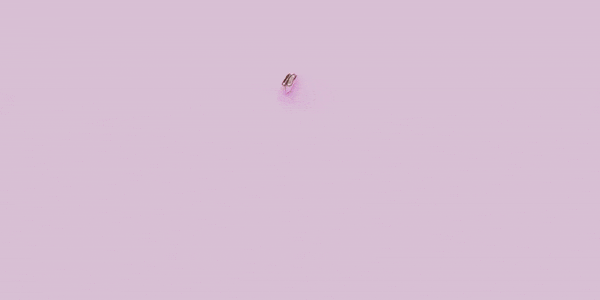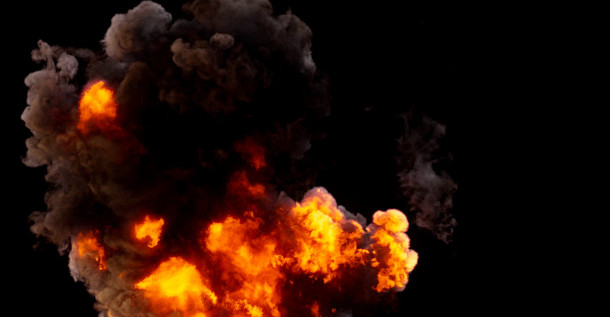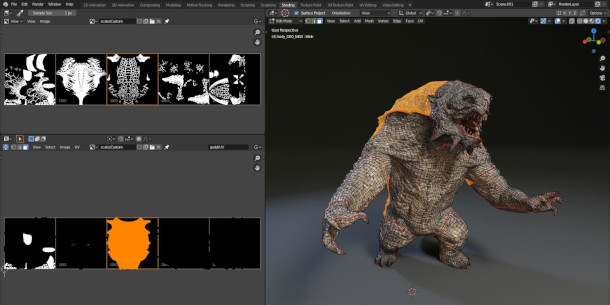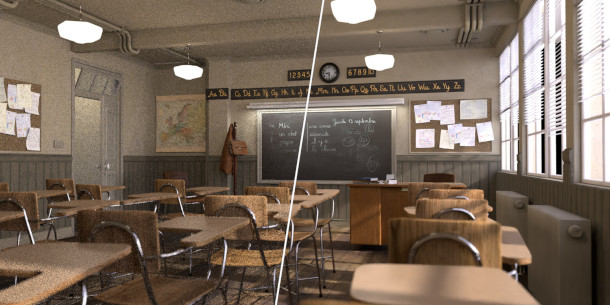Blender Foundation releases Blender 2.82

Blender 2.82 updates the open-source 3D software’s simulation toolsets, integrating the mantaflow framework for liquid and gaseous fluids, and adding support for internal air pressure in cloth sims.
The Blender Foundation has released Blender 2.82, the next update to the open-source 3D software.
The release introduces a new unified fluid simulation toolset, and removes obstacles to integrating Blender into production pipelines, adding UDIM support, USD export, and adopting the VFX Reference Platform.
Building on last year’s ground-breaking 2.80 release
The release builds on the successes of Blender 2.80, last July’s milestone update to the software.
Four years in the planning, the 2.80 update overhauled the open-source 3D software’s core architecture and workflow to improve its usability for professional production work.
Ubisoft, which has recently adopted Blender in its in-house TV animation studio, described the 2.80 update as “a game-changer for the CGI industry”.

Mantaflow integration provides unified gaseous fluid and liquid simulation
Although Blender is being increasingly adopted in production for modelling and layout work, many studios still rely on tools like Houdini for complex simulation work.
Blender 2.82 marks the first significant change the the software’s simulation toolset in some time, with the integration of open-source fluid simulation framework mantaflow.
Co-developed by graphics researcher Nils Thuerey, previously R&D lead at Scanline VFX, mantaflow was available as a separate branch of Blender for several years before reaching the main branch.
Its implementation both unifies and modernizes the software’s physics tools: gaseous and liquid simulations now use a common modifier and share a common user interface.
Liquid simulations also get a new FLIP solver. The hybrid particle/volume-based methodology, widely adopted in specialist simulation tools, promises to improve the realism of native Blender fluids.
In particular, the new solver promises to make it easier to recreate more complex real-world effects, with dedicated secondary particle types for spray, foam and bubbles.
The update also extends Blender’s cloth simulation tools, adding support for internal air pressure and internal springs, making it easier to simulate balloons and soft bodies.

Support for production standards: UDIMs, USD export and VFX Reference Platform
The release also introduces support for several important production standards, including the UDIM UV layout format pioneered by Weta, and now widely adopted in modelling and material authoring software.
It is implemented across all of Blender’s key toolsets, making it possible to display UDIMs in the Image and UV Editors, as shown above, and to paint onto UDIMs in the Image Editor and 3D viewport.
Scenes that use UDIMs can also now be rendered in both the Cycles and Eevee render engines.
Blender 2.82 also introduces initial support for USD, Pixar’s Universal Scene Description format for exchanging complex production data between graphics applications.
USD has been widely adoped in VFX production pipelines since it was open-sourced in 2016, and is now supported in many key DCC applications and renderers.
Blender’s own integration is still a work in progress – it’s limited to file export, and it doesn’t support USD layers and variants, or skeletal animation – but is still a significant step.
In addition, the Blender Foundation has committed to adhering to the VFX Reference Platform.
Overseen by the Visual Effects Society’s Technology Committee, the spec determines which versions of common programming libraries VFX tools should use, with the aim of streamlining pipeline integration.
Autodesk, Foundry, Pixar and SideFX all support the VFX Reference Platform in their own software.

Rendering changes: GPU denoising and custom shader AOVs
New rendering features in Blender 2.82 include the integration of Nvidia’s OptiX denoiser inside Cycles.
The AI-trained, GPU-based render denoising system, widely adopted in other renderers, provides an alternative to Blender’s native denoiser and Intel’s CPU-based Open Image Denoise, added in Blender 2.81.
In the initial release, it can only be used with Cycles’ new OptiX render backend, also introduced in Blender 2.81, and required a current-gen Nvidia RTX graphics card.
However, it is fully integrated with Blender’s view layer system, and supports multiple GPUs.
Cycles also gets support for custom shader AOVs, which should provide artists with finer control over the look of rendered output, and make it easier to debug scenes.
Eevee, Blender’s new real-time renderer, gets the option to display individual render passes in the viewport as well as the combined beauty render.
Passes supported include ambient occlusion, normal. mist and subsurface effects.
Other changes: new sculpting tools, Grease Pencil features and add-ons
Blender’s sculpting toolset – the subject of a major update in Blender 2.81 – continues to evolve, with the 2.82 release adding a new Slide/Relax tool for sliding the topology of a mesh while preserving its volume.
In addition, a number of existing brushes have been updated, including the Pose Brush added in 2.81, which now provides the option to set how many IK bones will be created to pose a character.
The Grease Pencil 2D animation toolset also gets a number of new features, including a Multiple Strokes modifier for generating new concentric strokes around the originals, and a new Polyline primitive.
Other changes include a new Eyedropper tool, and the option to control opacity, blending and onion skinning for individual channels within the Dope Sheet.
Outside of the core application, Blender 2.82 introduces a range of new officially approved add-ons, including Amaranth, Pablo Vazquez’s set of small workflow improvements, and a new sun position system.
As ever, the full changelog is much longer: you can find a complete list of new features via the links below.
Release date and system requirements
Blender 2.82 is available for Windows 7+, macOS 10.12+ and Linux. It’s a free download.
See Blender Foundation’s overview of the new features in Blender 2.82
Read the Blender 2.82 release notes
Full disclosure: this story based on one I wrote for BlenderNation as part of my work outside CG Channel.
